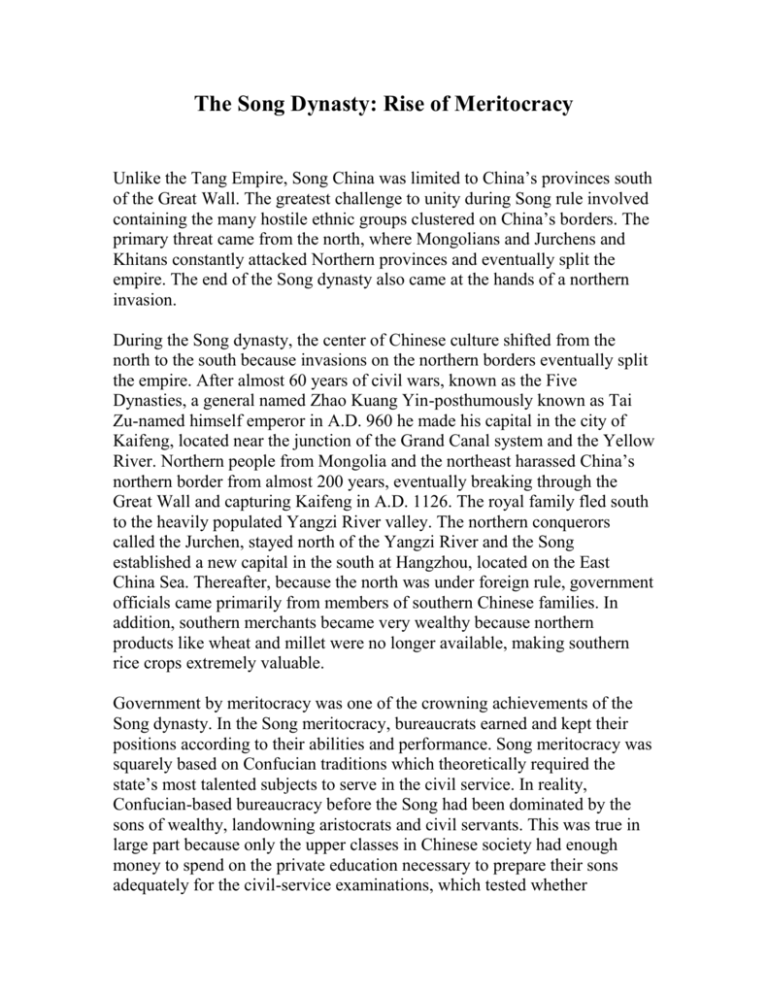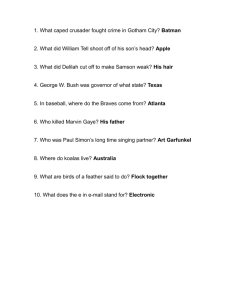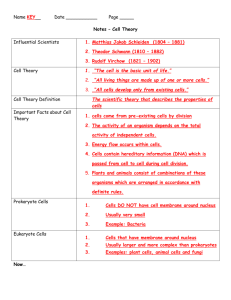The Song Dynasty
advertisement

The Song Dynasty: Rise of Meritocracy Unlike the Tang Empire, Song China was limited to China’s provinces south of the Great Wall. The greatest challenge to unity during Song rule involved containing the many hostile ethnic groups clustered on China’s borders. The primary threat came from the north, where Mongolians and Jurchens and Khitans constantly attacked Northern provinces and eventually split the empire. The end of the Song dynasty also came at the hands of a northern invasion. During the Song dynasty, the center of Chinese culture shifted from the north to the south because invasions on the northern borders eventually split the empire. After almost 60 years of civil wars, known as the Five Dynasties, a general named Zhao Kuang Yin-posthumously known as Tai Zu-named himself emperor in A.D. 960 he made his capital in the city of Kaifeng, located near the junction of the Grand Canal system and the Yellow River. Northern people from Mongolia and the northeast harassed China’s northern border from almost 200 years, eventually breaking through the Great Wall and capturing Kaifeng in A.D. 1126. The royal family fled south to the heavily populated Yangzi River valley. The northern conquerors called the Jurchen, stayed north of the Yangzi River and the Song established a new capital in the south at Hangzhou, located on the East China Sea. Thereafter, because the north was under foreign rule, government officials came primarily from members of southern Chinese families. In addition, southern merchants became very wealthy because northern products like wheat and millet were no longer available, making southern rice crops extremely valuable. Government by meritocracy was one of the crowning achievements of the Song dynasty. In the Song meritocracy, bureaucrats earned and kept their positions according to their abilities and performance. Song meritocracy was squarely based on Confucian traditions which theoretically required the state’s most talented subjects to serve in the civil service. In reality, Confucian-based bureaucracy before the Song had been dominated by the sons of wealthy, landowning aristocrats and civil servants. This was true in large part because only the upper classes in Chinese society had enough money to spend on the private education necessary to prepare their sons adequately for the civil-service examinations, which tested whether applicants should be eligible for government positions. In addition, for a long time, public servants received their positions through recommendations. Song emperors, however, insured that the most talented Chinese young men, despite their economic status, could become civil servants by seeking out promising students among all ranks of society. Conversely, more Chinese had the free time to study for the exams when the government-regulated equal field system fell into disuse after the eight century. Thus, during the Song dynasty, students showing aptitude were recruited and educated so that they would be able to take the all-important Civil-Service Exam. During the Song dynasty, as civil servant, or scholars, grew to be the most powerful people in the emperor’s government, the Civil Service Examination became the most important event in Chinese society. Civil servants were chosen according to the scores they achieved on the exam, also called “the ladder to the Clouds” The exam was exceedingly difficult: each of the four levels of increasingly challenging tests took all day and required superior knowledge of Confucian classic texts, poetry, government, administration, and sometimes calligraphy. Most students took the first exam around the age of 23, and the few people who passed the final tests between 2 and 10 percent of thousands that took the tests each year- were usually in their mid-30. Those who passed the exams were conferred the prestigious title of scholar and could become administration officials, poets, or historians. Ton insure that no corruption existed the Bureau of Examination Copyists copied every test before it was graded, so that no test taker’s handwriting could be recognized by the official exam correctors employed by the board of Civil office. Passing the exam, however, did not guarantee a candidate an automatic appointment to a position; it merely allowed him to apply for a job in the government. During the Song dynasty, a new and vibrant form of Buddhism called Chan became popular across East Asia. (In Japan, were it became quite prevalent, Chan is called Zen) Chan stresses personal enlightment not through study of classical Buddhist texts, but rather through intense, quiet meditation called zazen. The Chan sect was a small one that appealed primarily to the elite who could afford the time to meditate and to retreat into the world of contemplation. Chinese Buddhist monks were attracted to Chan because of simplicity and because it could easily be combined with Daoist ideas. Chinese Chan monks transported Zen teachings to Korea and Japan, and the religious connection became a path of cultural exchange between East Asia’s various cultures. The Song era saw the rise of the merchant class in Chinese society. In traditional Confucian theory, a merchant was considered lower than a peasant or artisan because a merchant neither worked land nor created a product. But the Song government realized that wealth could be raised by taxing commerce, so trade was encouraged both in China and overseas. A new strain of faster-growing rice, imported from Cambodia, doubled China’s output of the grain, allowing for surplus stock that could be traded to bring in extra wealth. This extra income allowed more merchants to enter the lucrative overseas trade. Chinese junks or ships sailed on China’s elaborate canal system and plied the coasts of East and Southeast Asia, trading the varied products of China’s agricultural and industrial might. Innovations in Chinese technology, in part made possible by the stable availability of books-and created other new products such as copper and paper money, as tea, coal, porcelain, and especially silk, became very popular in Korea, Japan, Persia, the Arab world, and East Africa.






